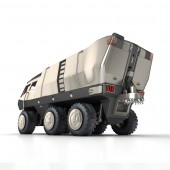DESIGN NAME:
Fire Knight
PRIMARY FUNCTION:
Fire Fighting Vehicle
INSPIRATION:
The long hot summer days on the Northern Hemisphere cause wildfires in many regions. Battling wildfires has got to be one of the toughest jobs.. As many vehicles, airplanes and manpower are needed, the traditional way of fighting, controlling and freezing forest fire is considered to be very expensive and also time consuming. These actions are combined with supply of heavy equipment efforts in different forest regions. Such as all-terrain vehicles; tracked or wheeled, fire rescue trucks; water tenders, wild land fire engines, fire pumps; foam pumps portable low- pressure pumps, portable pumps .etc. What the World needed is a much more effective tool to strike any fire fighting action. Fire prevention measures have been made efficiently by improved meteorological prediction and risk assessment. However when the fire starts the effective field studies are essential. Rapid changes in the world climate and distinct increases in the green house effects cause serious water shortages also and strongly affect the forest fire fighting theories and prevention methods all around the world. New generation forest fire fighting possibilities with the free sustainable material will be one of the vital contributions for the greenest world. As this is the most alarming problem of all nations, without discrimination, this well-thought out fire fighting vehicle is dedicated to all nation’s fire fighting heroes on the world. The more effective fire protection measures seem to lead to an accumulation of fuel in the forests. The policy of rapid initial attack is very effective, but does not seem to be adapted to large conflagration areas. Parallel to these phenomena the biodiversity of the world ecosystems is rapidly decreasing. The traditional mosaic-shaped fields and forests, rich in edge-effects, provide niches for rare and endangered flora and fauna. The World forests are characterized by complexity and fragility. Their management with the objectives of protection, production and biodiversity necessitates the mastering of especially adapted techniques. The aim of fire prevention is to define the different vulnerable zones of the field forest corresponding to soil characteristics, vegetation and relief. In addition to this, different research projects funded by the international contracts showed that scientific cooperation is considered as essential.
UNIQUE PROPERTIES / PROJECT DESCRIPTION:
The Fire Knight is specially designed treatment method for an open sore of the planet Earth: water shortage. The vehicle:
Uses the most sustainable material on the Earth to extinguish the forest fires.
Does not need to concern about the transportation of material to the zone as it can achieve regional material collection
Uses sand particles which mix with the carbon layer and precipitate the formation of peat soil layer which brings long-lasting advantages for sustainability and enrichment of vegetation.
Sand blasting method brings a new generic approach to the fire fighting system: blasting the fire. Partitioning the fire allows soil to contact with air and cool down faster. Chip removal technique is used at the flaming regions. High-pressurized sand particles batter the region and peel off the blasted parts on the trees and plants. The particles cover completely the flaming region, breaking contact with the fresh air. Moreover, the dust cloud created by sand blasting decreases the saturation of oxygen in the local atmosphere. Therefore, sand layer is an effective isolator for the areas died down. As a result of this, the system serves the preparation of fire breaks without cutting the trees and scarcely damaging the existing flora fauna.
Overcomes the vaporization of water and speed dissipation against the wind, increases the efficiency of blasting as the material used is sand.
Uses sand blasting method which brings a new generic approach to the fire fighting system: as blasting the fire. Partitioning the fire allows soil to contact with air and cool down faster. Therefore the vehicle achieves cooling down process while extinguishing.
Peels off the blasted parts on the trees, and isolates the died down regions from fire.
Prepare fire breaks without cutting the trees and scarcely damaging the existing flora fauna.
Has a blasting arm ,360 degree free to rotate around the vehicle, provides long range blasting in all directions
Has 6 blasting nozzles at the two sides, in order to be effective also on extinguishing the near surroundings.
is professionally designed to be made of fire resistant materials. The most effective composites and latest technology metal coating methods are thought to be used.
works with diligently chosen mechanical devices in order to get the best performance.
is able to clear away the active (the layer on the stem which is being on fire) and passive (the residual layer on the stem after the fire) carbon layers accumulated on the stems. Therefore it helps the flora fauna recondition itself.
evaluates the importance of staff safety at top levels with specially designed uniforms, sliding windshield protector and reflective body surfaces.
can effectively be used at purposely ignited fires like destroying the hay stacks in order to prevent the fire probability.
can be used in planting by the help of its shovel locating at the front side and its vacuum branch covered with toothed bar locating at the back side.
Consequently, the Fire Knight is an environment-friendly forest fire fighting vehicle working without water. In the conflagration area, it is capable of extinguishing the fire by using the most sustainable material: soil. Besides, it is also strongly effective on caring, protecting, and enhancing the vegetation even in the absence of fire.
OPERATION / FLOW / INTERACTION:
-
PROJECT DURATION AND LOCATION:
-
FITS BEST INTO CATEGORY:
Vehicle, Mobility and Transportation Design
|
PRODUCTION / REALIZATION TECHNOLOGY:
The material selection is made by focusing on the fire resistant properties of basic materials. Different combinations of usages are made to achieve the best protection and durability. The materials used at different sections are as follows:
The upper body part is a double aluminum layer between which an aggregate called perlite is fulfilled .The upperbody part is a double aluminum layer between which an aggregate called perlite is fulfilled. Perlite is an amorphous volcanic glass that has a relatively high water content, typically formed by the hydration of obsidian. It occurs naturally and has the unusual property of greatly expanding when heated sufficiently. Therefore it provides efficient isolation from ultimate heat transfers at the fire zone. The external aluminum layer is coated with porcelain enamel for extra protection. Reflective surfaces are for extra precaution against overheating of the ambient.
The chassis is made of steel also coated with porcelain enamel which is an inorganic and vitreous coating used on metals for protective and functional purposes. After applying enamel to the base surface, vitrification firing is carried out at a very high temperature. This procedure triggers between the two surfaces chemical and physical reactions which create a new material combining the properties of glass (hygiene and hardness) and those of the base surface (resistance, formability and lightness) in the case of metal. The coating is resistant to fire, cold (-50°C) and to heat (450°C), thermal shock and corrosion by acids and alkali at ambient temperature, organic solvents and atmospheric agents
The lower body (in dark color) is made of a fireproof composite called FyreRoc. The FyreRoc/carbon composite can still support heavy loads at an ultimate temperature of 800°C (1470°F) while the other identically sized materials (like carbon/epoxy, aluminum, steel are not able to. In addition to this high protection, the mineral perlite is filled between the layers of fireproof composite.
The windows are made of tempered glass and 26 inch rims are made of stainless steel.
SPECIFICATIONS / TECHNICAL PROPERTIES:
The mechanical specifications of all the machines used in the truck are determined carefully in order to achieve the best performance. The specifications are listed below:
The Motor:
Six numbers of electric motors are mounted independently on the upward freedom of wheels. The specifications of the electric truck motor are as follows:
Motor Type: 3 Phase AC
Horsepower: 90 hp
Power: 67 kW / 33 continuous
RPM: 3500-9700
Energy Capacity: PbA - 23 kWh/NiMH - 26 kWh
Battery Type: PbA/NiMH
Battery Modules: PbA 39/NiMH - 25
The Suspension System:
Wheel suspension system with double spring supports rely on each motor allowing permanent orthogonally of motor and the transmission components for continuous power transmission. Namely, the position of each motor can be adjusted to the position and angle of each corresponding wheel. All systems are designed by the design team.
The Transmission System:
Each wheel is manually or electrically controlled by torque system of each independent electric motor in the absence of transmission box. Electrical power driving system is used for variable torque distribution to each wheel by corresponding electrical motors.
Battery efficiency is conserved by incorporation of mode selectors, for both highways and unimproved terrain roads. The truck makes 60 miles per hour(max) on the highway road, and 25 miles/ hour (max) on the terrain pattern.
The mode selectors are part of computer controlled drive system which arrange the amount of torque by electronic circuits according to the mode preferred.
The conventional disk brakes system is used in the vehicle. The hybrid system will be protecting by IP.
The Power Generator:
The power generator on the truck responds to the needs of all 6 electric motors and the blasting mechanism also. This generator is 60 Hz Diesel Generator set which supplies 70kW (87.5 kVA) Power in stand-by mode, 65kW (81.3 kVA ) in prime mode. The fuel tank is modified and tank capacity is enlarged to 1400 liters. Standard integral set-mounted radiator system, designed and tested for rated ambient
Temperatures up to 50 °C, is used as the generator’s cooling system and simplifies facility design requirements for rejected heat.
The Batteries:
Nickel metal hydride (NiMH) is the technology of choice for the emerging hybrid electric vehicle and is gaining acceptance for mission critical backup power needs due to its excellent performance, high energy, reliability, safety and long life.
Cobasys NiMHax Battery Pack is used. The specifications are as follows:
NiMHax 336-70; 3360V, 8.5 Ah, 70kW, 2.8 kWh designed for light trucks. The dimensions are: 1017 x 442 x 218mm. The batteries are in activate in the case of emergency.
The Compressor:
Air-cooled 6-cylinder naturally aspirated in-line compressor is used in the truck for vacuum and blasting processes of sand particles. The compressor is air-cooled with integrated axial-flow blower and can operate at 2500rpm max. Power rating is 70 kW at 2300 rpm. The mean effective pressure is 6.45 bars.
TAGS:
-
RESEARCH ABSTRACT:
-
CHALLENGE:
-
ADDED DATE:
2010-11-30 00:14:32
TEAM MEMBERS (1) :
IMAGE CREDITS:
Hakan Gürsu, 2010.
|









